Redway nature trail website
From this site you can download the trail map and directions and the trail itself with the description of plants and animals you are likely to see along the way.
 TRAIL,
TRAIL,  MAP+DESCRIPTION
MAP+DESCRIPTIONThe rest of the site shows items that I was not able to pack into the hardcopy version of the nature trail such as 360 degree panoramas.
 Milton Keynes station. The large amounts of granite and concrete in this area can provide ideal habitat for some animals such as jumping spiders. The zebra spider shown right wonders around on sunny walls and suddenly jumps a considerable distance onto its prey.
Milton Keynes station. The large amounts of granite and concrete in this area can provide ideal habitat for some animals such as jumping spiders. The zebra spider shown right wonders around on sunny walls and suddenly jumps a considerable distance onto its prey.
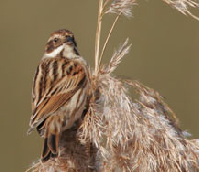 Teardrop lakes – Both common reed (Phragmites) and Reedmace (Typha) are common in this area along with reed buntings, a female shown left on common reed seed-
Teardrop lakes – Both common reed (Phragmites) and Reedmace (Typha) are common in this area along with reed buntings, a female shown left on common reed seed-
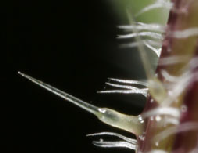 The bowl – in various places along the trail there are clumps of nettles. They are often a good indicator of heavily enriched soil, for example on the banks of streams where the nutrient laden silt is dumped in times of flood. Two of our most common and brightly coloured butterflies, small tortoiseshell and red admiral lay their eggs on nettles, look out for their black caterpillars. However be careful of the nettles stinging hairs, shown right.
The bowl – in various places along the trail there are clumps of nettles. They are often a good indicator of heavily enriched soil, for example on the banks of streams where the nutrient laden silt is dumped in times of flood. Two of our most common and brightly coloured butterflies, small tortoiseshell and red admiral lay their eggs on nettles, look out for their black caterpillars. However be careful of the nettles stinging hairs, shown right. 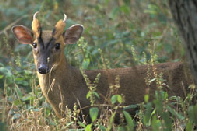 Crossing the tracks. In recent years muntjac deer, see image left, have become common in many parts of the country often causing damage by overgrazing woodland. If you are out and about in the early hours of the morning there are often deer grazing on the road embankments. I have even seen deer at 9 o’clock in the morning munching their way through grass in a local park, just vanishing into the shrubbery when I approached. I wonder how many of the local ‘big cat’ sightings were actually deer.
Crossing the tracks. In recent years muntjac deer, see image left, have become common in many parts of the country often causing damage by overgrazing woodland. If you are out and about in the early hours of the morning there are often deer grazing on the road embankments. I have even seen deer at 9 o’clock in the morning munching their way through grass in a local park, just vanishing into the shrubbery when I approached. I wonder how many of the local ‘big cat’ sightings were actually deer. 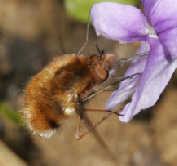 Granby roundabout(or is it officially Redmoor roundabout). One of the most frequent asked about insects is the bee-
Granby roundabout(or is it officially Redmoor roundabout). One of the most frequent asked about insects is the bee- Ashland. It is perhaps a bit optimistic to expect to see a buzzard , shown right, flying overhead here but I have seen them in many of the areas around Milton Keynes such as above the brickhill woods (the woods you can see on the hill looking south from Ashland) and north east of willan lake. Red kites have also been seen very close to Milton Keynes so its probably only a matter of time before they are spotted too.
Ashland. It is perhaps a bit optimistic to expect to see a buzzard , shown right, flying overhead here but I have seen them in many of the areas around Milton Keynes such as above the brickhill woods (the woods you can see on the hill looking south from Ashland) and north east of willan lake. Red kites have also been seen very close to Milton Keynes so its probably only a matter of time before they are spotted too.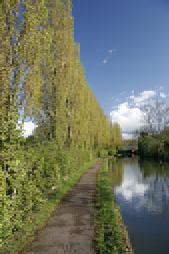 Simpson The designers of Milton Keynes made extensive use of poplars and willows as this type of tree grows very fast so giving an instant impact and they are very suitable for growing along river valleys. One of the most distinctive of the poplars are the tall thin Lombardy poplar (Populus nigra ‘Italica’), shown left, most specimens are male having only male catkins, these trees are generally thinner than the females. Other poplars you can find along the trail include grey, black, aspen and various fast growing hybrid poplars. It would be nice if someone could make a collection of leaves and bark rubbings (or photographs) as a basis for identifying them. Perhaps it would also be an idea to note other characteristics such as smell, some smell strongly of balsam, bud shape, and general outline of the tree.
Simpson The designers of Milton Keynes made extensive use of poplars and willows as this type of tree grows very fast so giving an instant impact and they are very suitable for growing along river valleys. One of the most distinctive of the poplars are the tall thin Lombardy poplar (Populus nigra ‘Italica’), shown left, most specimens are male having only male catkins, these trees are generally thinner than the females. Other poplars you can find along the trail include grey, black, aspen and various fast growing hybrid poplars. It would be nice if someone could make a collection of leaves and bark rubbings (or photographs) as a basis for identifying them. Perhaps it would also be an idea to note other characteristics such as smell, some smell strongly of balsam, bud shape, and general outline of the tree. Woughton park and Walton Hall. Like a number of parts of Milton Keynes, Walton Hall has a large population of great crested newts, common newts, frogs(photo left) and toads, this is despite the constant building works. The little plastic fences you see near any new development are supposed to trap the great crested newts which are then removed to a small concentration camp area for the period of the building works, they are then supposed to be brought back and released in to a ‘mitigation’ area. I am not aware of any careful scientific studies that shows this actually works and that the newts survive even though millions of pounds are spent on newt translocations each year. So if you’ve got a pond make it as newt friendly as possible as it may actually be the offspring of your newts that spread out and recolonise the denuded areas after building works.
Woughton park and Walton Hall. Like a number of parts of Milton Keynes, Walton Hall has a large population of great crested newts, common newts, frogs(photo left) and toads, this is despite the constant building works. The little plastic fences you see near any new development are supposed to trap the great crested newts which are then removed to a small concentration camp area for the period of the building works, they are then supposed to be brought back and released in to a ‘mitigation’ area. I am not aware of any careful scientific studies that shows this actually works and that the newts survive even though millions of pounds are spent on newt translocations each year. So if you’ve got a pond make it as newt friendly as possible as it may actually be the offspring of your newts that spread out and recolonise the denuded areas after building works.
 Monkston park river section. Kingfishers, photo right, are relatively common in many of the wet areas along the trail although all you normally see of them is a metallic blue streak shooting past low down along the river. This particular bid was very obliging during the winter of 2005/6 as it would come and perch right outside the Willan bird hide and dive in to catch fish in the scrape area. It had a very predictable routine for many weeks so all I had to do was choose a sunny day and sit in the hide with the camera, never had to wait more than 20 mins for it to turn up. Most nature watching is very hit and miss so it was nice to have one predictable bird especially one as spectacular as this.
Monkston park river section. Kingfishers, photo right, are relatively common in many of the wet areas along the trail although all you normally see of them is a metallic blue streak shooting past low down along the river. This particular bid was very obliging during the winter of 2005/6 as it would come and perch right outside the Willan bird hide and dive in to catch fish in the scrape area. It had a very predictable routine for many weeks so all I had to do was choose a sunny day and sit in the hide with the camera, never had to wait more than 20 mins for it to turn up. Most nature watching is very hit and miss so it was nice to have one predictable bird especially one as spectacular as this. Many of the trees in this section of the ouzel valley are white willows which are used for making cricket bats, the Parks Trust website gives more details on this. Also look out for many of the water plants growing in or along the river, these include the pink flowering rush (Butomus umbellatus), yellow yellowcress(Rorippa), and blue Brooklime (Veronica beccabunga), there are also plenty of white plants such as water crowfoot and arrowhead. See how many different types of plant you can find.
Woolstone medieval fishponds and other aspects of the historic landscape. Image showing ponds full of water, is the quality of photo good enough?
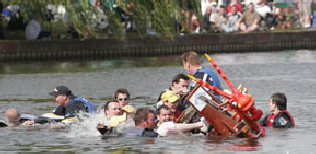 South lake Willan. Each year there is the popular dragon boat festival and many other watersports. Having all the lakes certainly makes the area more attractive both for people and wildlife. If you come here on a summer weekend and see it packed with families it may be rather a surprise to know that the jetties outside the pub and round the water-
South lake Willan. Each year there is the popular dragon boat festival and many other watersports. Having all the lakes certainly makes the area more attractive both for people and wildlife. If you come here on a summer weekend and see it packed with families it may be rather a surprise to know that the jetties outside the pub and round the water-
North lake Willan bird hide. Common terns, see photo, nest on the island and may bring their youngsters in front of the hide to bath or catch fish in the shallow water. Its rather a battle to keep some areas of the island clear of trees and shrubs for ground nesting birds such as terns. In recent years the parks trust have been using a combination of a herd of goats and volunteers to clear the scrub. The goats are left on the island for long periods to eat the vegetation, hopefully the parks trust volunteers are taken off by boat after a days work rather than being marooned.
The bird hide can be good at any time of year, there are always a range of common waterfowl such as canada and greylag geese, various ducks, gulls, cormorants, and sometimes egrets. In the winter there can be a greater range of ducks including goosander (photo), I came across this group of 7 males chasing one female while walking along the road bridge to the hide early one morning in February. There can also be quite a few snipe in the scrape in front of the hide but their excellent camouflage means you rarely see them unless you specifically scan the water margin very carefully.
 Peace pagoda and temple Most people walk past the stone circle and pagoda without a second thought but these sites are the focus of several ceremonies each year. Two of the most notable are the solstice at the stone circle (photo) and Hiroshima day at the peace pagoda(photo). As part of the Hiroshima day event lighted candles are floated out onto Willan lake in paper lanterns. Hiroshima nowadays is a modern city, completely rebuilt after total devastation and somewhat similar to Milton Keynes. Its easy to forget the hundreds of thousands of people who were killed either instantly or suffered a long and agonising death as a result of the atomic bomb. However the peace movement there is constantly working to rid the world of these terrible weapons.
Peace pagoda and temple Most people walk past the stone circle and pagoda without a second thought but these sites are the focus of several ceremonies each year. Two of the most notable are the solstice at the stone circle (photo) and Hiroshima day at the peace pagoda(photo). As part of the Hiroshima day event lighted candles are floated out onto Willan lake in paper lanterns. Hiroshima nowadays is a modern city, completely rebuilt after total devastation and somewhat similar to Milton Keynes. Its easy to forget the hundreds of thousands of people who were killed either instantly or suffered a long and agonising death as a result of the atomic bomb. However the peace movement there is constantly working to rid the world of these terrible weapons. 
gullivers land and ecological area.
The bird hide can be good at any time of year, there are always a range of common waterfowl such as canada and greylag geese, various ducks, gulls, cormorants, and sometimes egrets. In the winter there can be a greater range of ducks including goosander (photo), I came across this group of 7 males chasing one female while walking along the road bridge to the hide early one morning in February. There can also be quite a few snipe in the scrape in front of the hide but their excellent camouflage means you rarely see them unless you specifically scan the water margin very carefully.
 Peace pagoda and temple Most people walk past the stone circle and pagoda without a second thought but these sites are the focus of several ceremonies each year. Two of the most notable are the solstice at the stone circle (photo) and Hiroshima day at the peace pagoda(photo). As part of the Hiroshima day event lighted candles are floated out onto Willan lake in paper lanterns. Hiroshima nowadays is a modern city, completely rebuilt after total devastation and somewhat similar to Milton Keynes. Its easy to forget the hundreds of thousands of people who were killed either instantly or suffered a long and agonising death as a result of the atomic bomb. However the peace movement there is constantly working to rid the world of these terrible weapons.
Peace pagoda and temple Most people walk past the stone circle and pagoda without a second thought but these sites are the focus of several ceremonies each year. Two of the most notable are the solstice at the stone circle (photo) and Hiroshima day at the peace pagoda(photo). As part of the Hiroshima day event lighted candles are floated out onto Willan lake in paper lanterns. Hiroshima nowadays is a modern city, completely rebuilt after total devastation and somewhat similar to Milton Keynes. Its easy to forget the hundreds of thousands of people who were killed either instantly or suffered a long and agonising death as a result of the atomic bomb. However the peace movement there is constantly working to rid the world of these terrible weapons. 
gullivers land and ecological area.
 canal and pond and cricket pavilion/parks trust HQ The Grand Union canal that flows through Milton Keynes now gets more traffic than ever, photo red canalboat, although now its mainly leisure craft rather than freight traffic. The canal is also heavily used for fishing, including for a number of competitions. Its always surprising that there is enough food in the very turbid waters to support a large fish population.
canal and pond and cricket pavilion/parks trust HQ The Grand Union canal that flows through Milton Keynes now gets more traffic than ever, photo red canalboat, although now its mainly leisure craft rather than freight traffic. The canal is also heavily used for fishing, including for a number of competitions. Its always surprising that there is enough food in the very turbid waters to support a large fish population.

 Campbell park. One quite small park has a real mixture, some formal highly decorative plantings, water features and sculptures, a high viewpoint and setting for concerts, a wild area, sports pitch and nice ponds. Sheep do a better job of cutting the grass in campbell park than mowers do, photo left, as with a regularly mown sward you get very few different kinds of wildflowers. The slopes are also rather uneven and difficult to cut. But there are some areas where the groundsmen needs a very fine finish and no droppings. The cricket square is used by many different teams, including this women’s final, photo right.
Campbell park. One quite small park has a real mixture, some formal highly decorative plantings, water features and sculptures, a high viewpoint and setting for concerts, a wild area, sports pitch and nice ponds. Sheep do a better job of cutting the grass in campbell park than mowers do, photo left, as with a regularly mown sward you get very few different kinds of wildflowers. The slopes are also rather uneven and difficult to cut. But there are some areas where the groundsmen needs a very fine finish and no droppings. The cricket square is used by many different teams, including this women’s final, photo right.
Theatre district  (at this point there is a choice, either stick on cycle route 51 straight down through the shopping and business area to the station taking your chances with large numbers of people, parked cars, busses etc or turn left and go down the redway along the northern edge of fishermead and oldbrook which avoids the city centre). Plane trees. City air purified by plants especially these trees which also help to cool the atmosphere in summer. During the day leaves take in carbon dioxide and give out oxygen, during the process they also loose large amounts of water vapour which cools their environment. In addition particles of pollution in the air such as those given out by traffic are captured on leaves and bark so don’t end up damaging people’s lungs.
(at this point there is a choice, either stick on cycle route 51 straight down through the shopping and business area to the station taking your chances with large numbers of people, parked cars, busses etc or turn left and go down the redway along the northern edge of fishermead and oldbrook which avoids the city centre). Plane trees. City air purified by plants especially these trees which also help to cool the atmosphere in summer. During the day leaves take in carbon dioxide and give out oxygen, during the process they also loose large amounts of water vapour which cools their environment. In addition particles of pollution in the air such as those given out by traffic are captured on leaves and bark so don’t end up damaging people’s lungs.
 (at this point there is a choice, either stick on cycle route 51 straight down through the shopping and business area to the station taking your chances with large numbers of people, parked cars, busses etc or turn left and go down the redway along the northern edge of fishermead and oldbrook which avoids the city centre). Plane trees. City air purified by plants especially these trees which also help to cool the atmosphere in summer. During the day leaves take in carbon dioxide and give out oxygen, during the process they also loose large amounts of water vapour which cools their environment. In addition particles of pollution in the air such as those given out by traffic are captured on leaves and bark so don’t end up damaging people’s lungs.
(at this point there is a choice, either stick on cycle route 51 straight down through the shopping and business area to the station taking your chances with large numbers of people, parked cars, busses etc or turn left and go down the redway along the northern edge of fishermead and oldbrook which avoids the city centre). Plane trees. City air purified by plants especially these trees which also help to cool the atmosphere in summer. During the day leaves take in carbon dioxide and give out oxygen, during the process they also loose large amounts of water vapour which cools their environment. In addition particles of pollution in the air such as those given out by traffic are captured on leaves and bark so don’t end up damaging people’s lungs.
City centre. the city centre is particularly nice in the early morning when there are few people around and you have time to appreciate the artworks, avenues of trees, the wildlife feeding on last night’s discarded food scraps and do some window shopping. Starlings [pied wagtails?]
Business district
many of the grid road shrub and tree plantations have native species such as bluebells, primroses, campion and violets in the spring these species were actually planted in 1987/8 and you can sometimes see large clumps of white violets for example near the bowl that might date from a single individual.
In flower in july: Creeping buttercup, water plantain, great willowherb, birch seeds(still green), maple keys, spear thistle, meadowsweet, indian balsam, dodder on nettles, water dock, arrowhead, yellow water lily, bur reed, flowering rush
Insects
Red admiral, peacock, small tortoiseshell, painted lady, common blue, butterflies; various dragonflies and damsels; bumble bees(especially as they are easy to spot with their weaving flight when you are cycling along), wasps, beetles.